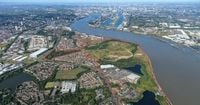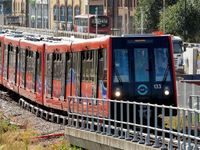In a move set to reshape southeast London’s future, Chancellor Rachel Reeves is expected to announce next week a long-awaited extension of the Docklands Light Railway (DLR) to Thamesmead. The decision, anticipated in the upcoming Budget on November 27, 2025, has been met with a chorus of support from government officials, housing developers, and local leaders, who argue it could unlock tens of thousands of new homes and jobs, while also stirring up debate about its true impact and priorities for the capital’s transport network.
According to BBC London, the Treasury is poised to back the £1.7 billion project, which would see a new DLR branch built from Gallions Reach, with a stop at Beckton Riverside, before tunneling under the Thames to reach North Thamesmead. The extension is forecast to create up to 25,000 new homes and 10,000 jobs, with construction slated to begin in 2027 and trains running by the early 2030s. The government’s support is expected to enable Transport for London (TfL) and the Greater London Authority to borrow the necessary funds, possibly with the Treasury contributing to repayments over time.
For many, the DLR extension is more than a transport project—it’s the linchpin of a broader regeneration strategy. As Housing Today reports, housing association Peabody is masterminding the transformation of the 1960s Thamesmead estate and its surrounding areas. Peabody’s ambitious plan aims to deliver 20,000 new homes across South and West Thamesmead and the Thamesmead Waterfront, with the DLR extension unlocking the potential for 15,000 homes on a 100-hectare brownfield site in the north. The Thamesmead Waterfront, developed in partnership with Lendlease, was recently named a potential new town in the government’s New Towns Taskforce report.
John Lewis, executive director of sustainable places at Peabody, welcomed the government’s signal of support, telling Housing Today: “Thamesmead has huge potential to be a thriving new town, and Government support for the DLR extension takes us one step further to unlocking this. Enabling a major uplift in housing and boosting significant economic growth, this vital transport link will help to bring lasting benefits locally, regionally and nationally.”
London Mayor Sadiq Khan, who has long lobbied for the project, echoed this optimism. “I’m really pleased that the government is backing the DLR extension to Thamesmead—something I’ve long called for alongside London’s businesses and communities,” Khan told BBC London. “The project is a win-win and a massive vote of confidence in London. It will not only transform travel in a historically underserved part of the capital, but also unlock thousands of new jobs and homes, boosting the economy not just locally but nationally.”
Supporters argue the new line will dramatically improve connectivity for Thamesmead, an area long criticized for its isolation from London’s rapid transit network. Current journeys from Thamesmead to the City of London can take about an hour; the DLR extension is expected to cut this to 35 minutes, and bring Stratford within a half-hour’s reach. A Treasury spokesperson told Building that the move would “deliver much-needed new homes, new jobs, and quicker commutes—the building blocks for boosting growth, putting more pounds in pockets.”
The extension is also expected to “crowd in nearly £18 billion of private investment” over the next 30 years, according to government sources cited by Housing Today. For the regeneration of Thamesmead, this influx of capital is seen as a game-changer, potentially spurring not just housing but also retail, leisure, and community infrastructure.
Yet, beneath the celebratory headlines, some local observers are sounding a note of caution about the real-world impact of such a massive infrastructure project. The blog From The Murky Depths points out that while the DLR extension is being touted as the catalyst for thousands of new homes, actual delivery in the area has historically lagged behind promises. Peabody, for example, has completed just one of seven planned plots near Abbey Wood station in over a decade, and some vacant sites are not expected to see development until the late 2030s.
“The key question now is whether landowners Peabody and Lendlease will actually build housing at any sort of pace if the DLR is extended at high cost,” the blog notes, highlighting that only about 600 homes have been completed by Peabody in south Thamesmead over twelve years, despite proximity to the Elizabeth line and other major transport links.
There’s also debate about how transformative the DLR extension will be for most Thamesmead residents. While the new line will serve North Thamesmead, much of the sprawling town is already well-connected by frequent bus services to Abbey Wood station, which offers fast links to central London. “For most existing Thamesmead residents the DLR will be no quicker to reach than Abbey Wood station given the town’s sheer sprawl,” From The Murky Depths argues, questioning whether the high cost is justified for a project that benefits only a portion of the community.
According to the Abbey Wood and Thamesmead Opportunity Area Framework, around 7,500 of the new homes in North Thamesmead will require high-capacity transit like the DLR, while a proposed Bus Rapid Transit scheme could serve up to 8,000 homes. Critics say the focus on the DLR may divert attention and resources from other areas, such as Barking Riverside and Dagenham Dock, where tens of thousands of new homes are planned but only limited transport improvements are on the horizon.
Political debate is also swirling around the project’s broader implications. While City Hall and local Labour and Conservative politicians have welcomed the announcement, some are lamenting the shelving of other major transport schemes, such as the Bakerloo Line extension and the West London Orbital rail line, which are expected to be deprioritized for now. The DLR extension’s estimated £1.7 billion price tag and its focus on a single corridor have prompted questions about whether it represents the best use of limited public funds, especially as demand for new homes and better transport stretches across London’s eastern boroughs.
Despite the criticisms, the mood among key stakeholders remains buoyant. Len Duvall, London Assembly member for Greenwich and Lewisham, described the government’s expected commitment as “fantastic news,” urging that “the focus must now be on ensuring the funding and planning begin quickly, so that construction can begin as swiftly as possible.” John Dickie, chief executive of BusinessLDN, added that the chancellor’s backing “will unlock private investment into housing in Thamesmead, and support employment and social mobility.”
As the Budget approaches, all eyes are on Chancellor Reeves and the details of her announcement. Will the DLR extension finally break the cycle of underinvestment and isolation for Thamesmead? Or will it become another chapter in London’s long saga of ambitious plans and uneven delivery? For now, the city waits—hopeful, but not without skepticism, that this time, the trains will indeed arrive.


